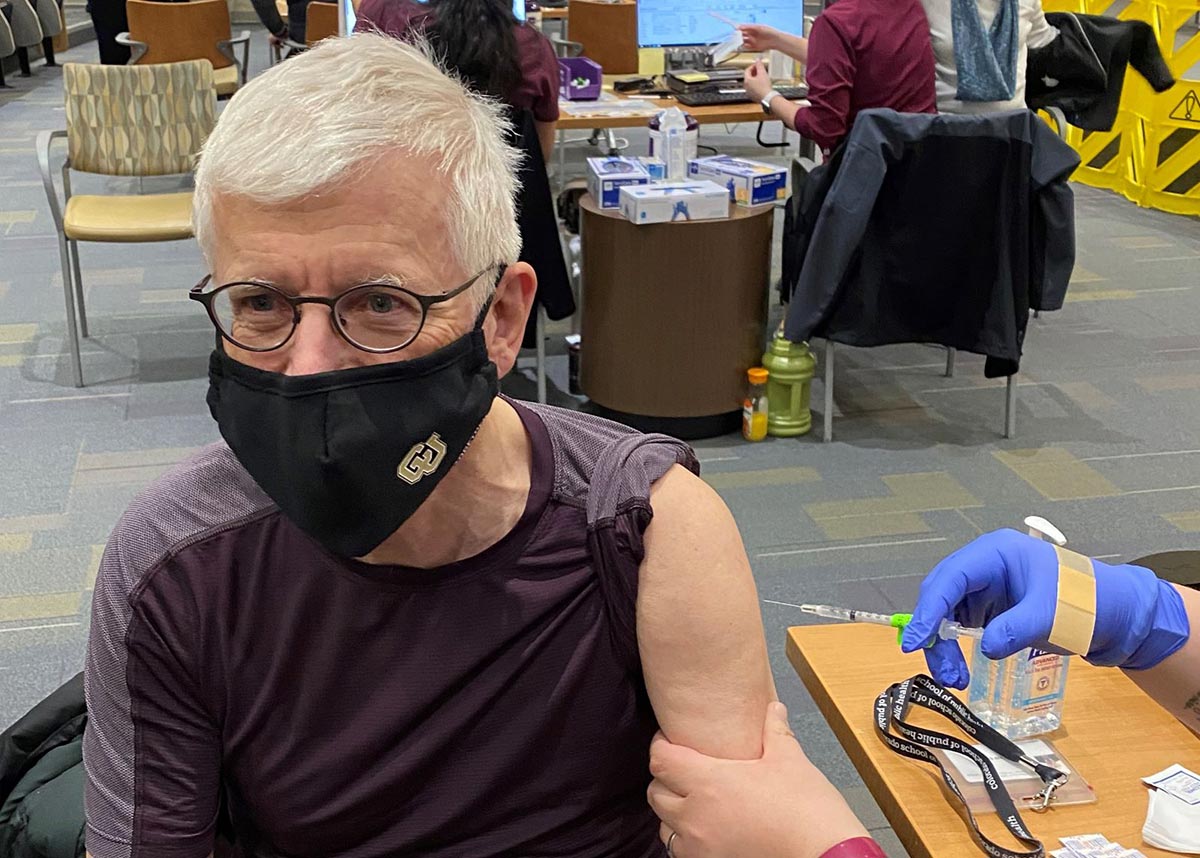Dean's COVID-19 Commentary
-

The COVID-19 Pandemic: The J&J vaccine returns, Colorado climbs, and the Chauvin verdict
Apr 26, 2021A glimpse of normalcy brings impatience as to the rapidity of regaining what we have lost with the pandemic. At the moment, Colorado’s epidemic curve is still rising but its growth may be slowing. Predicting the timing of its future downturn is difficult, but vaccination should win out in the weeks to come.Full story -

The COVID-19 Pandemic: The pandemic reignites, the J&J pause, and county confusion
Apr 19, 2021The pandemic persists, although too many Coloradans are “over it.” Yesterday’s hospitalization count was 520, well above the March 14 low of 283. Colorado is not the only state with a rising epidemic curve.Full story -

The COVID-19 Pandemic: Another surge, vaccines for all, and pandemic poetry
Apr 12, 2021Not a good pandemic week in Colorado. The positive news of rising vaccination rates and falling hospitalizations among those 65+ is now counterbalanced by indications of a “fourth surge” as the epidemic curve has definitely taken off.Full story -

The COVID-19 Pandemic: The epidemic curve wobbles, spring arrives, and AAPI attacks continue
Apr 5, 2021The pandemic has provoked and exacerbated prejudice, particularly against Asian-Americans, fueled by the rhetoric of the former Administration. Words and actions matter, and these attacks are unconscionable.Full story -

The COVID-19 Pandemic: The epidemic curve oscillates, and worse, another mass shooting—in Boulder
Mar 29, 2021Gun violence has long been labeled as a public health crisis. Gun violence has become the norm, as have mass shootings. With more than 38,000 deaths annually from firearms, around 24,000 from suicide and 14,000 from homicide, it is a crisis and a series of preventable tragedies.Full story -

The COVID-19 Pandemic: March Madness, predicting the future, and Ethiopia
Mar 22, 2021Immunity is increasing as vaccination increases and pressure is rising for easing restrictions as the pandemic has abated substantially in much of the United States. In Ethiopia, the worst consequence of prejudice is playing out with relatively little global notice—the genocide of the Tigrayans.Full story -

The COVID-19 Pandemic: Good news in Colorado and the US, but what about the world?
Mar 15, 2021For the United States, vaccine supply is ramping up quickly with President Biden promising that all adults will be eligible for vaccination by May 1, and that there will be a semblance of normalcy by July 4. Looking globally, the picture is mixed with “haves” and “have-nots.”Full story -

The COVID-19 Pandemic: The one-year anniversary of Colorado’s first case—in memoriam
Mar 8, 2021March 5 marked the one-year anniversary of Colorado’s first case of COVID-19, soon followed by the first death on March 13. This is the toll in Colorado over the year since then: 435,000 identified cases; an overall total, including symptomatic and asymptomatic, of perhaps 1.3 million; 24,000 hospitalizations; and 5,984 deaths.Full story -

The COVID-19 Pandemic: More variant strains and thinking about jazz
Mar 1, 2021The news this week on the pandemic can be easily summarized: vaccines and variants—encouraging and discouraging. The pandemic’s toll reaches beyond disease and death to our economy, harming so many sectors that are integral to our world, like restaurants and the performing arts.Full story -

The COVID-19 Pandemic: Herd immunity—what is it and how do we achieve it?
Feb 22, 2021Herd immunity has been controversial and in the news since the start of the pandemic. In some higher vaccine delivery scenarios, the threshold range for herd immunity is reached across the summer. Modeling suggests that herd immunity can be reached at the state level as the fall begins. Undoubtedly, many groups within the state will not be adequately protected and I anticipate that distancing and mask mandates will still be in place.Full story -

The COVID-19 Pandemic: Risk & Uncertainty
Feb 16, 2021William Lowrance defined safety as: “a thing is safe if its risks are judged to be acceptable.” I have long used this definition in framing problems in risk for its universality. It fits well with dilemmas posed by the challenges in decision-making around the pandemic, as we make efforts to reopen and edge towards “normalcy.”Full story -

COVID-19 Pandemic: Governor Polis spins the dial, the Supreme Court rules, and politics continue
Feb 8, 2021There is an inherent tension between assuring that the epidemic curve continues its descent, and that economic activity ascends. Finding that balance has been challenging across the pandemic in Colorado and elsewhere, and we lack consensus on where the balance point lies.Full story -

The virus has mutated, vaccination policies proliferate, and Colorado's pandemic curve continues down
Feb 1, 2021This has been a month that began with optimism and ends with the realities of providing vaccines to the world, and the troubling emergence of SARS-CoV-2 strains that may be more transmissible and more lethal than the circulating strain.Full story -

COVID-19 Pandemic: Vaccine rollout falters, but a national plan at last
Jan 25, 2021After less than a week in office, the Biden-Harris Administration is moving forward with a national plan to address the COVID-19 pandemic. By itself, the release of the plan on January 21 is reassuring, as is the emphasis on science (the word appears 46 times) and evidence (the word appears 18 times). The scope of the plan matches the enormity of the pandemic.Full story -

Colorado's epidemic pauses, and science returns to the White House
Jan 19, 2021Last week, writing about the insurrection at the Capitol was inescapable; this week the same is true for tomorrow’s presidential inauguration and its consequences for public health. The high-profile announcement of the Biden-Harris science team is encouraging and a turn-around.Full story -

2021 Starts: Where were you on January 6, 2021?
Jan 11, 2021History imprints us indelibly with momentous events and the days when they happened. Some dates are remembered because of tragedies; annually we note these dates and remember the event and where we were at the moment. January 6, 2021: our Capitol desecrated by a violent mob—I was in zoom meetings during a pandemic, at home.Full story -

The COVID-19 Pandemic: Will 2021 bring the end of the pandemic?
Jan 4, 2021Yes, 2021 will mark the start of the turn toward normalcy, at least the 2021 version. That new normalcy will not directly mirror 2019 or the “carefree years” before.Full story -
Will the end of 2020 bring the start of the end of the pandemic?
Dec 21, 2020This is my last commentary for 2020. I am proud that the Colorado School of Public Health has played key roles with many partners to help slow the COVID-19 pandemic. My metaphorical model predicts a healthier 2021.Full story -

The COVID-19 Pandemic: The epidemic curve soars across the U.S. and flattens in Colorado
Dec 14, 2020There had been warnings of a “dark winter” from many; predictably it has arrived. The daily death count in the United States, now reaching over 3,000, has been compared with the numbers from the September 11 terrorist attacks (2,605) and Pearl Harbor (2,403).Full story -

The COVID-19 Pandemic: Vaccines are here—who gets them?
Dec 7, 2020Vaccines against SARS-CoV-2 have been produced with extraordinary rapidity, reflecting technological advances and the urgency of the pandemic. On December 5, there were 2,190 deaths across the United States, equivalent to about three deaths every two minutes.Full story



